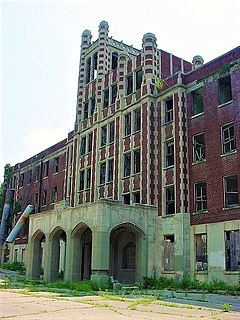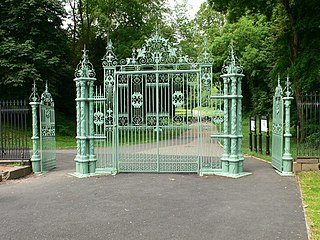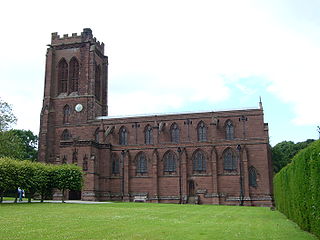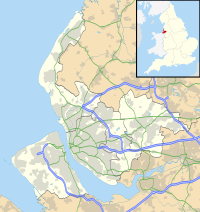
Somerleyton is a village and former civil parish in the north of the English county of Suffolk. It is 4.5 miles (7.2 km) north-west of Lowestoft and 5.5 miles (8.9 km) south-west of Great Yarmouth in the East Suffolk district. The village is closely associated with Somerleyton Hall and was largely rebuilt as a model village in the 19th-century at the direction of Samuel Morton Peto. The parish was combined with Herringfleet and Ashby to create the parish of Somerleyton, Ashby and Herringfleet in 1987.

Eaton Hall is the country house of the Duke of Westminster. It is 1 mile (2 km) south of the village of Eccleston, in Cheshire, England. The house is surrounded by its own formal gardens, parkland, farmland and woodland. The estate covers about 10,872 acres (4,400 ha).
St Helens is a large town in Merseyside, England, with a population of 102,629. It is the administrative centre of the Metropolitan Borough of St Helens, which had a population of 176,843 at the 2001 Census.

The Waverly Hills Sanatorium is a former sanatorium located in southwestern Louisville/Jefferson County, Kentucky.

Purley on Thames is a village and civil parish in Berkshire, England. Purley is centred 3 miles (4.8 km) north-west of Reading, 1 mile (1.6 km) east of Pangbourne, and 22 miles (35 km) south-east of Oxford. Consequently, Reading is the principal social, economic and cultural centre for the people of Purley. Historically, Purley comprised three separate manors and associated settlements. In the centre there is an historic area named variously Lething or Burley (Domesday) which accommodated traders and craftsmen alongside the main Reading to Oxford road.

Eccleston is a village and civil parish of the Borough of Chorley in Lancashire, England. It is beside the River Yarrow, and was formerly an agricultural and later a weaving settlement.

Eccleston is a civil parish in the Metropolitan Borough of St Helens, Merseyside, England. At the 2011 Census, it had a population of 10,433.

Hangleton is a residential suburb of Hove, part of the English city and coastal resort of Brighton and Hove. The area was developed in the 1930s after it was incorporated into the borough of Hove, but has ancient origins: its parish church was founded in the 11th century and retains 12th-century fabric, and the medieval manor house is Hove's oldest secular building. The village became depopulated in the medieval era and the church fell into ruins, and the population in the isolated hilltop parish only reached 100 in the early 20th century; but rapid 20th-century development resulted in more than 6,000 people living in Hangleton in 1951 and over 9,000 in 1961. By 2013 the population exceeded 14,000.

Pontypool Park is a 150-acre (0.61 km2) park in Pontypool, Torfaen, Wales. The park was formerly the grounds of Pontypool House and was laid out in the closing years of the 17th century for John Hanbury, an ironmaster, who is closely associated with Japanware. The grounds were purchased by the local authority in 1920, while the estate house was leased, and later sold, to the Sisters of the Holy Ghost to become St. Alban's RC High School. The former stables now house the Torfaen Museum. The grounds contain a number of structures including a double ice house, the Folly Tower and the Shell Grotto. The park is entered through the Pontymoile Gates. The gates, the grotto and the stables are all Grade II* listed structures, while the former hall and the ice house are listed Grade II.

Elswick is a rural village and civil parish on the Fylde coast of Lancashire, England. At the 2011 Census, it had a population of 1,079.

Little Hulton is an area in the City of Salford, Greater Manchester, England, 3.4 miles (5.5 km) south of Bolton, 7 miles (11.3 km) northwest of Salford, and 9 miles (14.5 km) northwest of Manchester. Within the boundaries of the historic county of Lancashire, Little Hulton is bordered by Farnworth to the north, Walkden to the east and Tyldesley to the south.

St Mary's Church is in the village of Eccleston, Cheshire, England, on the estate of the Duke of Westminster south of Chester. The church is recorded in the National Heritage List for England as a designated Grade I listed building. It is an active Anglican parish church in the diocese of Chester, the archdeaconry of Chester and the deanery of Chester. Its benefice is combined with that of St Mary, Pulford. The Dukes of Westminster are buried in the adjacent Old Churchyard.

St John the Baptist's Church is an Anglican church in Hove, part of the English city of Brighton and Hove. It was built between 1852 and 1854 to serve the community of the Brunswick area of Hove, which had originally been established in the 1830s.

The Upper Brook Street Chapel, also known as the Islamic Academy, the Unitarian Chapel and the Welsh Baptist Chapel, is a former chapel with an attached Sunday School on the east side of Upper Brook Street, Chorlton-on-Medlock, Greater Manchester, England. It is said to be the first neogothic Nonconformist chapel, having been constructed for the British Unitarians between 1837 and 1839, at the very beginning of the reign of Queen Victoria. It was designed by Sir Charles Barry, later architect of the Palace of Westminster.

St Mary's School is on the west side of Eaton Road in the village of Eccleston, Cheshire, England. It is recorded in the National Heritage List for England as a designated Grade II* listed building, and is still in use today, now known as Eccleston C-of-E Primary School.

St Helens is a large town and the administrative seat of the Metropolitan Borough of St Helens in Merseyside, England. The town was incorporated as a municipal borough in 1868, responsible for the administration of the four townships and manors of Eccleston, Parr, Sutton and Windle. In 1887 this role was expanded to a county borough, which was superseded in 1974 by the larger metropolitan borough.

Heveningham Hall is a Grade I listed building in Heveningham, Suffolk. The first house on the site was built for the politician and regicide William Heveningham in 1658. The present house, dating from 1778 to 1780, was designed by Sir Robert Taylor for Sir Gerald Vanneck, 2nd Baronet with interiors by James Wyatt. The hall remained in the Vanneck family until 1981.

Blythe Hall is a large grade II listed country house in Lathom, Lancashire, England, some 3 miles (5 km) north-east of Ormskirk.

The Church of St Mary, Lowe House is a Roman Catholic Parish church situated on North Road in St Helens, Merseyside. The present church was founded in 1924 and staffed by the Society of Jesus until 1981. It is a Grade II listed building with Romanesque and Gothic features.

3, The Grove, Highgate, in the London Borough of Camden, is a 17th-century house built by William Blake. In the 19th century it was home of the poet Samuel Taylor Coleridge; in the 20th, the novelist J. B. Priestley; and in the 21st, the model Kate Moss. It is a Grade II* listed building.




















